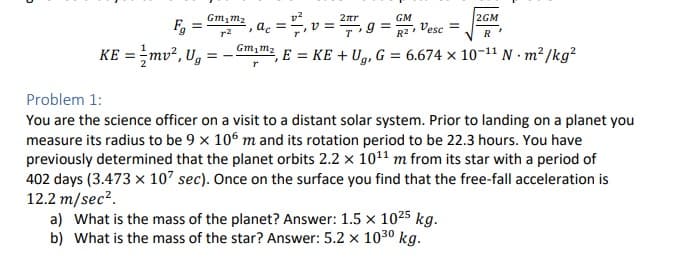You are the science officer on a visit to a distant solar system. Prior to landing on a planet you measure its radius to be 9 x 106 m and its rotation period to be 22.3 hours. You have previously determined that the planet orbits 2.2 x 10¹¹1 m from its star with a period of 402 days (3.473 x 107 sec). Once on the surface you find that the free-fall acceleration is 12.2 m/sec². a) What is the mass of the planet? Answer: 1.5 x 10²5 kg. b) What is the mass of the star? Answer: 5.2 x 103⁰ kg.
You are the science officer on a visit to a distant solar system. Prior to landing on a planet you measure its radius to be 9 x 106 m and its rotation period to be 22.3 hours. You have previously determined that the planet orbits 2.2 x 10¹¹1 m from its star with a period of 402 days (3.473 x 107 sec). Once on the surface you find that the free-fall acceleration is 12.2 m/sec². a) What is the mass of the planet? Answer: 1.5 x 10²5 kg. b) What is the mass of the star? Answer: 5.2 x 103⁰ kg.
College Physics
10th Edition
ISBN:9781285737027
Author:Raymond A. Serway, Chris Vuille
Publisher:Raymond A. Serway, Chris Vuille
Chapter26: Relativity
Section: Chapter Questions
Problem 9P: A muon formed high in Earth's atmosphere travels toward Earth at a speed v = 0.990c for a distance...
Related questions
Question
100%

Transcribed Image Text:D
Gm₁m₂
Fg
KE = mv², Ug = -
2πr
, ac = =²₁, v = ²7₁
T
Gm₁m₂
GM
g = G, Vesc =
2GM
R
, E = KE + Ug, G = 6.674 x 10-¹1 Nm²/kg²
Problem 1:
You are the science officer on a visit to a distant solar system. Prior to landing on a planet you
measure its radius to be 9 x 106 m and its rotation period to be 22.3 hours. You have
previously determined that the planet orbits 2.2 x 10¹¹ m from its star with a period of
402 days (3.473 x 107 sec). Once on the surface you find that the free-fall acceleration is
12.2 m/sec².
a) What is the mass of the planet? Answer: 1.5 x 1025 kg.
b) What is the mass of the star? Answer: 5.2 x 1030 kg.
Expert Solution
This question has been solved!
Explore an expertly crafted, step-by-step solution for a thorough understanding of key concepts.
This is a popular solution!
Trending now
This is a popular solution!
Step by step
Solved in 2 steps with 2 images

Knowledge Booster
Learn more about
Need a deep-dive on the concept behind this application? Look no further. Learn more about this topic, physics and related others by exploring similar questions and additional content below.Recommended textbooks for you

College Physics
Physics
ISBN:
9781285737027
Author:
Raymond A. Serway, Chris Vuille
Publisher:
Cengage Learning

College Physics
Physics
ISBN:
9781305952300
Author:
Raymond A. Serway, Chris Vuille
Publisher:
Cengage Learning

University Physics Volume 3
Physics
ISBN:
9781938168185
Author:
William Moebs, Jeff Sanny
Publisher:
OpenStax

College Physics
Physics
ISBN:
9781285737027
Author:
Raymond A. Serway, Chris Vuille
Publisher:
Cengage Learning

College Physics
Physics
ISBN:
9781305952300
Author:
Raymond A. Serway, Chris Vuille
Publisher:
Cengage Learning

University Physics Volume 3
Physics
ISBN:
9781938168185
Author:
William Moebs, Jeff Sanny
Publisher:
OpenStax

Principles of Physics: A Calculus-Based Text
Physics
ISBN:
9781133104261
Author:
Raymond A. Serway, John W. Jewett
Publisher:
Cengage Learning

Modern Physics
Physics
ISBN:
9781111794378
Author:
Raymond A. Serway, Clement J. Moses, Curt A. Moyer
Publisher:
Cengage Learning

College Physics
Physics
ISBN:
9781938168000
Author:
Paul Peter Urone, Roger Hinrichs
Publisher:
OpenStax College